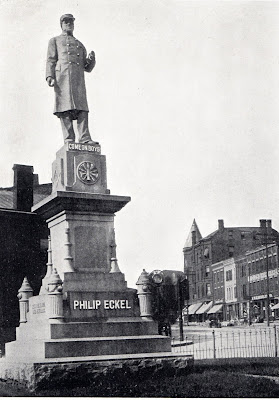Ithaca, NY. Andrew Dickson White statue on Cornell University quad. Karl Bitter, sculptor, 1915. Photo: Samuel D. Gruber 2012.
Public Sculpture: Andrew Dickson White at Home on Cornell Quad
by Samuel D. Gruber
I recently wrote about the monument to Syracuse fireman and philanthropist Hamilton S. White. Now I'd like to turn to a statue of his cousin, Andrew Dickson White (1832 – 1918), who is sitting pretty on Cornell University's historic quad, in Ithaca, New York. Andrew White was an educator, diplomat, historian, and bibliophile.
White was also co-founder with Ezra Cornell of Cornell University, where today he sits in bronze, very much at home in front of the classical style Goodwin Smith Hall. The statue, by noted American Renaissance sculptor Karl Theodore Francis Bitter (1867-1915), was installed almost a century ago, in 1915. Austrian-born Bitter was a leading sculptor of memorials and architectural sculpture.
Bitter and White chose the seated position for the commemorative statue. He had previously used the pose for a statue to Dr. William Pepper, placed on the campus of the University of Pennsylvania in 1896, and in 1914 and 1915, about the time he was working on the Andrew White representation, on statues of Thomas Jefferson and Alexander Hamilton.
Philadelphia, Pa. Statue of Dr. William Pepper, University of Pennsylvania. Karl Bitter, sculptor 1896. Photo from Schevill, Ferdinand, Karl Bitter: A Biography (Chicago, Illinois: University of Chicago Press, 1917).
This posture has a long tradition; in Greek and Roman sculpture philosophers, poets (and some gods) were often depicted seated, and Roman emperors were also sometimes shown seated. Statues of enthroned leaders - emperors, kings and popes - have been common since the Middle Ages. For men of ideas and culture the seated posture came with age and implied sagacity, and this format was especially revived by sculptors of the American Renaissance movement as an alternative to the ever-popular standing and equestrian figure formats. There are many early 20th-century examples of seated figures, and in my recent travels I seem to be quite attuned to them. For example, a seated figure of Benjamin Franklin by sculptor John J. Boyle was installed in 1899 in front of Philadelphia's Main Post Office, at 9th and Chestnut Streets (it is now on the University of Pennsylvania campus), and a copy was placed in Paris in 1905.
Paris, France. Benjamin Franklin monument at Square de Yorktown, 1899 / 1905. John J. Boyle, sculptor. Photo: Samuel D. Gruber (2013)
In 1910, John Quincy Adams Ward created a bronze statue of financier August Belmont, originally for the Belmont burial plot, but is now in front of the the Preservation Society of Newport County at the corner of Bellevue and Narragansett avenues in Newport.
\
Newport, Rhode Island. August Belmont statue, John Quincy Adams Ward, sculptor, 1910. Photo: Samuel D. Gruber (2008).
Andrew White was Cornell's first president and served as a professor in the Department of History. He was intensely interested in architecture, and he donated 4,000 architecture books to Cornell to help teach architecture (as well as the remainder of his 30,000 book collection) and this became the basis of the Cornell Library's esteemed architecture collection. White commissioned Cornell's first architecture student William Henry Miller to build his impressive house on the Cornell campus.
Architecturally, the Andrew White statute serves an important purpose. It humanizes the vast Cornell quad, one of the largest formal spaces on any American campus. The relaxed pose is a softer counterpoint to the formal classical columns of Goldwin Smith hall, erected in 1904 afters designs by Carrére and Hastings. The presence of the seated, relaxed Andrew D. White makes the big space seem smaller; more like a living room or salon than a military assembly ground.
White was the U.S. Ambassador to Germany (1879–1881), and first president of the American Historical Association (1884–1886). Upstate New York Republicans unsuccessfully attempted to nominate him for governor in 1876 and for congress in 1886. Following his resignation as Cornell's President in 1885, White served as Minister to Russia (1892–1894), President of the American delegation to The Hague Peace Conference (1899), and again as Ambassador to Germany (1897–1902)
Ithaca, NY. Andrew Dickson White statue on Cornell University quad. Karl Bitter, sculptor, 1915. Photo: Samuel D. Gruber 2012.
Ithaca, NY. Andrew Dickson White statue on Cornell University quad. Karl Bitter, sculptor, 1915. Photo: Samuel D. Gruber 2012.


.JPG)
.jpg)











